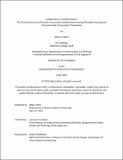Collaboration in Unlikely Spaces: The Characteristics and Promise of Successful Collaboration Among Affordable Housing and Environmental Conservation Proponents
Author(s)
Fullem, Abby K.
DownloadThesis PDF (44.85Mb)
Advisor
Susskind, Lawrence
Terms of use
Metadata
Show full item recordAbstract
There is a decreasing amount of available land and competing priorities for the use of it. Land value appreciation and the effects of climate change reduce the amount of viable land at affordable prices. Sectors and stakeholders with contending interests for land parcels have a choice; they can contest the other, ignore the other and try to maximize their interests, or collaborate to maximize both of their interests on that land.
Two sectors that face this choice are affordable housing developer non-profits and conservation land trust non-profits. Both are land-based, in need of inexpensive land, and struggling to achieve their missions alone. Collaboration, I suggest, is the preferred route for these sectors to take in the face of increasing competition, as it allows each sector to simultaneously advance their own interests by leveraging the other sector’s strategies and tools, and form a more powerful political coalition to further their shared interests.
I describe and analyze an action research case study I conducted on a cross-sectoral collaboration in the Hudson Valley of New York State. Hudson Valley Affordable Housing and Conservation Strategy (HVAHCS) is comprised of ten affordable housing and conservation land trust non-profits that are choosing to collaborate in the face of increasing competition. Through a review of consensus building, network building, and collective impact theories, as well as interviews and experience as a member of the HVAHCS facilitation team, I look at what enables their cross-sectoral collaboration, and how they approach obstacles to it. I conclude with recommendations for other groups considering collaboration as a means to advance their individual and shared interests in the same physical space.
Learnings from this action research case study point to the importance of employing an interests-based approach, allowing ideas and priorities to emerge from the network of organizations, balancing capacity and diffused leadership within the collaborative, using a third-party facilitator, prioritizing relationship-building, building a shared understanding, and supporting the organizations within the collaborative.
Date issued
2023-06Department
Massachusetts Institute of Technology. Department of Urban Studies and PlanningPublisher
Massachusetts Institute of Technology